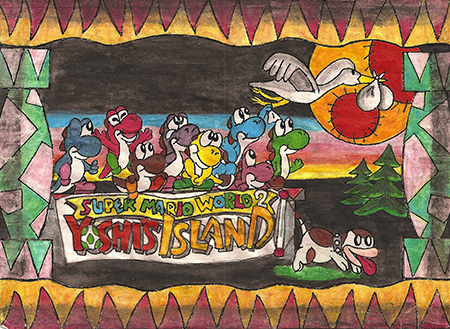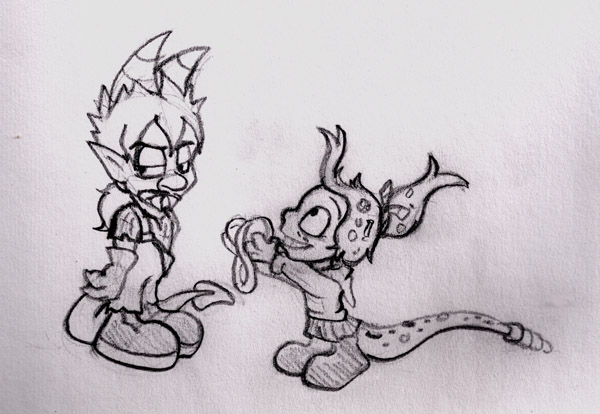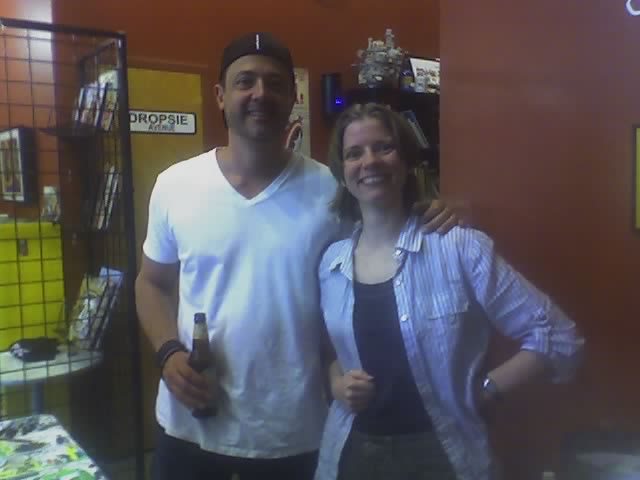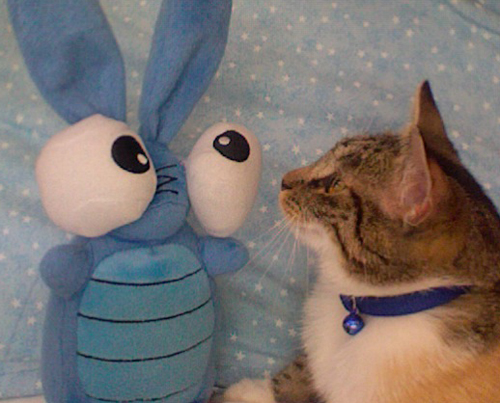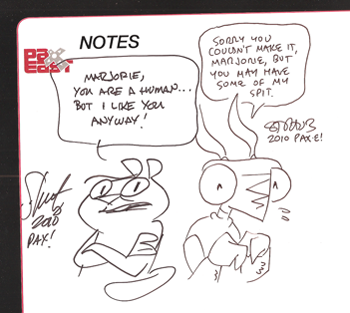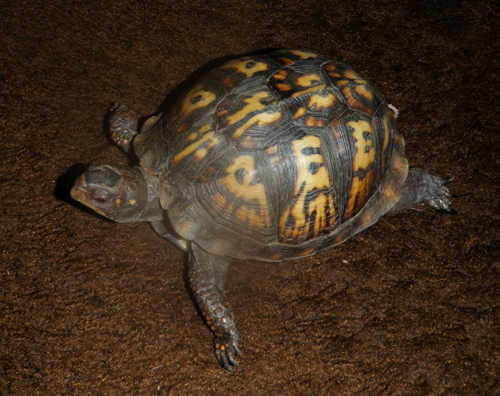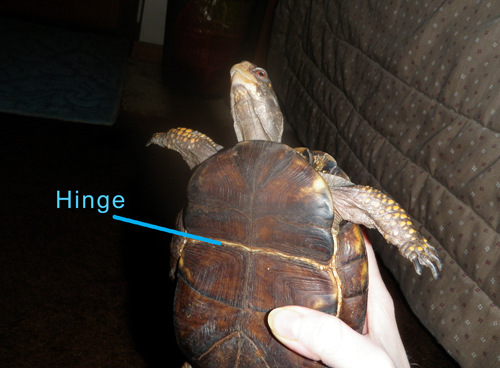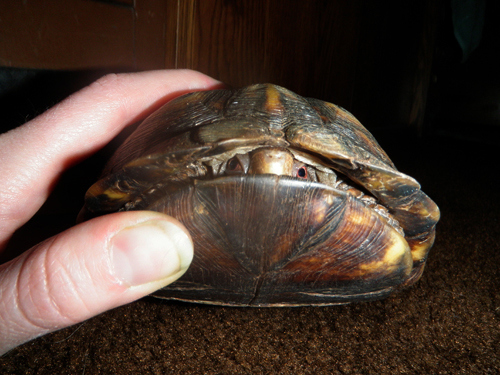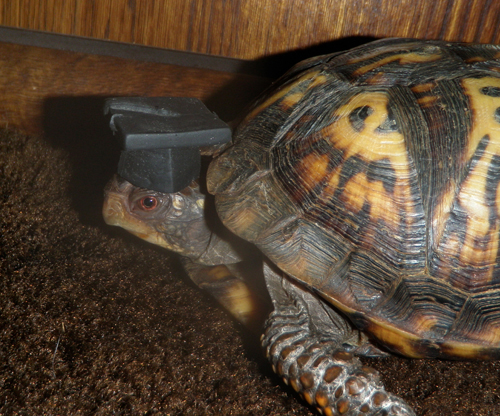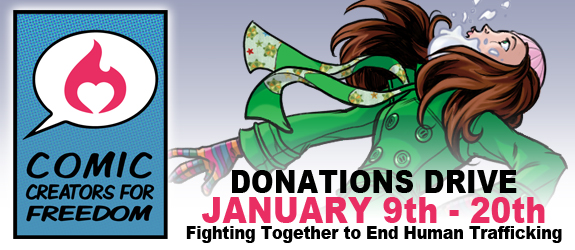A blog for the Lepus Studios website, which is home to the webcomics Draconics Wicked and Urban Underbrush (www.lepusstudios.com). I write about comics and whatever else interests me.
Thursday, December 20, 2012
Caius Christmas
Tuesday, December 18, 2012
My Top Five Least Favorite Christmas Specials
First, in order to understand the story, one must understand that Nico is the product of a brief fling between two adults. That aspect could still be okay if it were subtle, but the event is referenced repeatedly and with an unnecessary amount of detail. I suspect many parents have felt ambushed by this special. If parents want to teach their children about this kind of thing while the kids are still young, that's fine. If parents want to wait until their kids are older, that's fine too. But that decision probably shouldn't be made by cartoon reindeer.
-Marj
www.lepusstudios.com
Friday, December 14, 2012
Power Up, Power Down
Tuesday, December 11, 2012
Christmas Rush
Monday, November 19, 2012
Does Not Compute
I got my original Mac Book in 2006 and upgraded it a bunch of times. I doubled the RAM within the first year, replaced the hard drive two years ago, and went through more rechargeable batteries than I want to remember. I liked my first computer and was content to just keep rebuilding it. But it turns out, even if you keep the hardware and software current, laptops have a finite life span. My old computer has more than its share of dings and scratches. The hinge is loose and I literally have a piece of masking tape holding one of the latches on. But the cosmetic damage wasn't the problem. Too many internal parts were wearing out. The disk reader quit working, it has trouble holding wifi signals, and the screen as been gradually growing darker for some time now. When you work in visual arts, the screen is kind of important.
Now I have a new Mac Book Pro. It has all the features I want and all of them work as they're supposed to. Having nothing broken feels like an embarrassment of riches.
I'm not going to get rid of my old computer just yet. I'd like to use it for traveling and maybe let my art students borrow it from time to time. Before it goes into active retirement, I'd like to take a moment to remember all of its accomplishments:
- I did the last 1/4 of my animations on it, back when I was a character animator for a computer game.
- I used it for all demonstrations and archival work for the art classes I teach on weekends.
- I used it to demonstrate painting in Photoshop to my former online class.
- It got me through grad school when I earned my master's degree.
- I learned HTML on it and used it to write all my websites.
- I prepped and colored every episode of Urban Underbrush and Draconis Wicked with it...until now.
It really had a wonderful life. I look forward to wearing out the next one.
-Marj
www.lepusstudios.com
Wednesday, November 7, 2012
Wreckin' Machine
This movie is a big deal for the Rishel Family, and not just because so many of us are animation fans and/or casual gamers. It’s because my cousin Brian worked on the film. Brian has been doing behind-the-scenes stuff for Disney for many years, but this is the first time he’s contributed so much to a blockbuster movie. The next time you watch Wreck-It Ralph, look for Brian Rishel’s name in the credits. He’s the Post Production Lead Title Designer (it shows up shortly after the music credits). Congratulations, Brian. You’re finally getting the recognition you deserve.
If you haven’t seen Wreck-It Ralph yet, do yourself a favor and don’t read any reviews except mine. With this kind of story, reviewers won’t post spoilers, but they will be tempted to give hints about the plot. And, much like a real video game, hints can give too much away. All the threads should unravel nicely on their own, as long as you don’t go pulling on any of them too soon.
Okay, now about the movie itself. If you’ve seen the trailers, you know that Wreck-It Ralph is the story of a video game bad guy who is tired of being the villain. He can’t change the rules of his own game, so he travels to other games where he might have a shot at being the hero. On the surface, this looks like another story about a protagonist trying to improve his life while proving all the doubters wrong. It’s really a story about the nature of heroism. And the world of video games is a great place to explore the concept of heroism. If the moral had been about love, confidence, loyalty or any other popular theme, it would have been a waste of a theme. As the story begins, we learn that Ralph wants to be a hero so that people will treat him better. So game-hopping Ralph goes through the motions of being a hero without helping anyone. (Good Guy Ralph actually makes things much worse.) When Ralph forgets about his own quest and focus on helping others, he finally starts becoming the person he wants to be. Wreck-It Ralph has a good, real moral that isn’t explored often enough in these kinds of movies: You can’t be a hero to make people like you. You have to like people enough to be heroic for them.
But the best thing about Wreck-It Ralph is that the creators seem to get video games. Its quite common yet always disappointing to watch a show based on something that the authors themselves don’t understand (like Dreamworks movies and Dr. Seuss stories or family sitcoms and…pretty much any topic you can think of). Wreck-It Ralph was made by people who grew up on video games and were ready to pour all that knowledge and love into the crafting their digital world.
And if your local theater still keeps it’s little corner arcade going, you can bet that you’ll want to give those old games a second look on your way out.
-Marjorie Rishel
www.lepusstudios.com
Wednesday, October 24, 2012
Back to School Survival Guide #3: Pranks for the Memories (Part Two)
(Honestly, I did not expect to take so long to finish this. Back to school stuff seems a little out of place when it’s running in late October, but I promised you a part two, so a part two you shall have.)
This time, I’m breaking down some popular jokes to explain why they work or don’t work. If you’re not a student, you may want to read this anyway. There are some good bits of joke etiquette in here, somewhere.
Running Gags
A running gag is a repeating joke. These gags are usually effective on TV but they don’t always work in real life. Usually, there’s an easy way to tell if a gag is working: The more people join in, the funnier the joke is. If you are the only person participating in the gag, then you are probably the only person who thinks it’s funny. Don’t discourage anyone from playing along.
Inside Jokes
An inside joke is a private joke shared by a small group of people. Often, inside jokes are personal or embarrassing, which somehow makes them funnier. There’s usually nothing wrong with inside jokes, except when outsiders think that the joke is about them. Imagine that you’re walking past a small group of people who suddenly start laughing. You ask them what’s so funny and they all get quiet and say that it’s nothing. It’s easy to suspect that they’re laughing at you, right? The group knows this, but they can’t explain themselves without revealing their embarrassing secrets. If you’re part of a group that uses inside jokes, prepare a safe explanation in ahead of time. So when someone asks you “what’s so funny?” you can give him a vague, but reassuring answer, like, “We were remembering something stupid that happened on Friday. It’s nothing serious.”
Making Fun of Teachers
All teachers know that their students want to make fun of them. (This even applies to some college professors.) Frankly, your teacher would rather you vent your frustrations with harmless words than break down in the classroom. They’ll be good sports as long as you follow one simple rule: Don’t make fun of an adult who is in the room with you. Putting down your teachers right in front of them makes it look like they don’t deserve respect. Be polite. Make fun of your math teacher in science class, your science teacher in music class, and when you’re on the bus, make fun of everybody but the bus driver.
Toxic Jokes: Pranks to Avoid
A few popular pranks that are more trouble than they’re worth. Plus they can hurt you as much as your victims. Avoid them at all costs.
Pranking Your Helpers
Springing pranks is like setting traps. The tricky part is getting someone to walk into your trap. An easy way to do this is to ask people to do things for you. For example, you might think a funny prank would be to lock someone in a supply closet. But no one is in the supply closet, so you ask your friend if he would please, please, please put some heavy boxes away for you. The trouble with this strategy is that it only punishes people who are nice to you. The obvious problem here is that you are teaching people to never help you. The less obvious problem is psychological. People are conditioned to expect a reward for good deeds, usually in the form of a “Thank You” or some other kind words. Whenever someone who expects a reward is punished instead, it creates intense feelings of betrayal and resentment. You may be dishing out more of an emotional sucker-punch than you ever intended.
Scolding and Teasing
When people (both kids and adults) yell or scold, a part of them is saying, “It is VERY important to me that you listen to these words.” If you choose this moment to joke around, you are sending the message, “I won’t listen, and I will keep others from listening too.” Humor doesn’t fix this kind of situation. It throws gas on the fire. And it may cause the yellers to direct their anger at you. If you think yelling and scoldings are unfair, you don’t always have to put up with them, but you should find a safer way to deal with it.
Hiding People’s Stuff
This is a crime of opportunity. Someone leaves something unattended, his friends stash it, and then they watch him panic when he finds it missing. The trouble with this prank is that there’s no good way to end it. If the prankster returns the missing items right away, people usually complain that the joke ended too soon. So everyone has to sit and wait awkwardly for the right time to resolve the situation. This can make the prankster can feel almost as trapped as the victim. Plus, it’s a tense situation, and tension only makes people expect a bigger punch line. In the end, the missing stuff is either returned safely, returned damaged, lost or stolen. None of these outcomes are particularly funny and they leave everyone feeling unsatisfied. This one just isn’t worth the trouble.
In Conclusion…
You may be asking yourself, “Hey, I’m just trying to have fun, why do I have to follow so many rules?” Bringing humor means that you’re adding something new to an ordinary situation. And if you’re the person who’s added something new then you are responsible for the results. Jokes and pranks are a bit like pets. People enjoy their antics, but if they run wild and cause trouble, then it is the owners’ responsibility to keep them in line.
-Marj
www.lepusstudios.com
Wednesday, September 26, 2012
Back to School Survival Guide #3: Pranks for the Memories (Part One)
In past years, I’ve written about getting help from teachers and spotting bullies. This year I want to write about something more fun: classroom jokes and pranks.
Have you ever noticed how certain kids pull jokes all the time while others get busted whenever they open their mouths? Some kids just know what they can get away with. I’m going to try and explain why some jokes are okay while others lead to problems. (Disclaimer: Your results may vary, depending on school culture and teacher’s sense of humor. Please put advice from parents, teachers and principals ahead of the random advice you get from strangers on the internet. And don’t use my blog as an excuse for bad behavior. I don’t need that kind of trouble.)
Are Jokes Good or Bad?
Secretly, most teachers like a good joke. After all, jokes from students can relieve stress, improve student socialization, and develop the creative parts of the mind. These are all things that good teachers want to encourage. But a teacher’s first mission is to make sure you learn something. So if your jokes disrupt the lessons and get in the way of that goal, your teacher will try to stop to you.
Pranksters, What’s Your Point?
Your intentions, good or bad, make a difference. An experienced teacher can usually spot the difference between friendly banter and mean-spirited humor. In other words, teachers are more likely to let you slide if you’re not trying to hurt anything. So what is your own goal for your jokes and pranks? It should be to give everyone a laugh and, maybe, show off how clever you are. If you want to put down other students, humiliate your teacher, or trip up today’s lesson, change your mission. Otherwise, you are better off skipping the jokes all together (and possibly finding yourself a good therapist.)
Besides, considerate jokes are usually funnier (at least in schools, anyway.) A lot of kids feel stress, or guilt from mean jokes. Even kids who laugh along often feel conflicted when others are being hassled. Don’t be mean and you’ll amuse more of the people that you’re trying to impress.
Pardon the Interruption.
Making jokes on your own time (lunch, recess, bus rides, etc.) should never be a problem. But, let’s say you’re in class. Can you jump in without landing in trouble? Maybe, maybe not, but here are a few tips that could improve your odds:
First, don’t wear out your welcome. In my experience, people can usually handle two or three interruptions before taking it seriously. If you or someone else has already interrupted a class, you may have used up your joke quota. If you think it's safe, keep the interruptions short. A fast joke is less likely to get you in trouble than a long, drawn out one. And be sure to pace your jokes. Five jokes spaced out over two hours is less annoying than five jokes back to back.
While you're at it, try to stay on topic. Jokes about today’s lesson prove that you can pay attention, while you’re having fun. And your jokes might help other students remember the lessons and do better on tests. That would make you a hit with the students and teachers.
Finally, and perhaps, most importantly of all, work on your timing. Good comedians say that timing is the most important part of humor. This is doubly true in schools. Avoid interrupting the most important parts of instructions or the key moments in discussions.
Taking Responsibility
Sometimes, no matter how careful or well meaning you are, someone may still get mad at your jokes. If this happens out in the real world, you can sometimes tell people to lighten up. But school rules are different. If someone in charge tells you off for clowning around, you say, “Sorry, it won’t happen again.” And then, unfortunately, you have to mean it. Lie low for the rest of class, maybe the rest of the day, to prove that you're serious. And don’t drag out your apology. A long, disruptive apology is often worse than whatever you’re apologizing for.
Heck is Other People
One of the worst things that can happen to you is having someone else take your joke too far. You might make a short, tasteful joke, only to have some other students add their own mean, disruptive comments on top of yours. Then you all end up looking like jerks. And if you try to explain that these other kids aren’t a part of your act, your teacher will think that you’re causing a disruption and the other kids will think you’re a traitor. The best thing to do is to keep quiet until things settle down. You can explain yourself to your friends and teachers after class. If anyone is still mad at you, you have to accept that. After all, the disruption may not have been your fault, but it was a result of your actions.
Summary
If you’re ever stuck, remember these basic rules of school humor: Don’t be disrespectful and try to keep it short. Stick to this, and maybe you’ll have your fun without serving any time in detention.
Next time, we’ll explore the kinds of jokes people play and which ones work. Until then, please prank responsibly.
-Marj
www.lepusstudios.com
Sunday, September 16, 2012
Welcome, New Gallery
I’ve recently expanded the Gallery section of Lepus Studios to include some of my fan art. Visitors can now explore my Super Mario Sculpture Gallery, a set of tiny polymer clay sculptures, based on Nintendo’s beloved characters. And (there’s no way to say this without sounding a little crazy) the collection has about 350 different pieces.
Why did I do it? About ten years ago (long before I was drawing webcomics), I was really interested in miniature sculptures. I wanted to make myself a set of Super Mario characters (I’ve been a huge Nintendo fan since I was twelve years old). I started with a little Mario (small enough to stand on a dime), and then I built the other characters loosely to scale with him. However, I never set up any parameters about which characters were important enough to make the cut. In a month I had about fifty characters. The next batch doubled my collection. For the last decade I’ve been adding to the horde each time I finish a new game. I usually only make a handful of little guys at a time, but it adds up.
Of course, I can never replicate every character. Over twenty years of Super Mario games have generated more characters than I could keep up with. I had to set some rules about which ones should be included:
- I only sculpt characters. No props, items, or power-ups.
- I only sculpt one version of each character. No different statues for Fire Mario, Cloud Mario, Tanooki Mario etc.
- I don’t add any new characters unless: A: they appear in more than one game, B: they play a key role in one game, or C: I find them interesting and really want to try sculpting them.
Until now, I never intended to make my fan art public. It’s always been something I did just for my own amusement. But this stuff is starting to pile up, and it feels strange to keep it all to myself.
To be fair, I’ve sited Nintendo as the legal owner of all Super Mario characters. Nothing in the statue gallery is for sale. I’m not even running any advertisements on the pages that show Nintendo characters so I won’t directly receive any profits from displaying them (aside from the attention it might bring.)
So if you enjoy Nintendo games, miniatures, or just want to see how strange my work can get when I have time on my hands, please Check Out the Gallery.
-Marj
www.lepusstudios.com
Wednesday, August 1, 2012
Something Different
I'm doing something a little different with Urban Underbrush right now. I've been trying my pen at some short, stand-alone comics that don't belong to any particular story arc. I've done some stand-alone comics before, but usually as bookends between chapters. I usually prefer writing big stories, but the big stories aren't coming as easily lately. It might be time for a change of pace.
Expect this type of comic for the entire month of August. We'll return to chapters in September. If you've been thinking about getting your friends into Urban Underbrush, but you don't want to make them read the long story arcs, then now might be a good time to introduce people to the comic. As always, each comic has it's own Facebook and Twitter buttons to make sharing a breeze.
Hope you enjoy the comics.
-Marj
lepusstudios.com
Monday, July 23, 2012
Delays Ahead
I've just spent my last two weeks teaching a very extensive digital arts class, which left little time for comic drawing. I've used up my buffer on both Draconis Wicked and Urban Underbrush.
To complicate matters, I have to leave town for a week and there will probably be no internet where I'm heading.
Expect Urban Underbrush to return on August 2. Draconis will return on August 13 at the latest.
Thanks for your patience and understanding.
Sunday, July 1, 2012
Pearls Before Pittsburgh
I didn’t know what to expect from Mr. Pastis. What do cartoonists talk about? Would he discuss his drawing methods? His writing methods? The advantages and disadvantages of digital distribution versus print distribution? (Would anyone else find that interesting?)
He kept it light and gave a talk that everyone could appreciate. This was good because there were a lot of kids in the audience (kudos to the parents who brought them there – you are parenting right.) Stephan talked about his characters, his inspirations, and how he started his cartooning career. He even shared some favorite complaint letters.
The lion’s share of his lecture was a “book reading.” How does a cartoonist do a book reading? He picks out some favorite comic strips and reads the dialogue out loud while a large screen projection of each panel is displayed on the wall behind him. Usually, he didn’t even have to read the last panel. As soon as the punchline went up, the crowd was laughing too hard to hear him anyway.
Stephan puts a lot of himself into his art, but it’s hard to get a sense of who he is as a person just from reading his work or listening to his talk. He presents himself in an accurate and straight-forward way, but then he wraps that presentation in a thick layer of self-deprecating humor. (Regular “Pearls” readers know that he beats himself up quite a bit.) Trying to know the man through his work is like looking at him through water, but then that self-deprecation is like that handful of dust thrown in that water, keeping us from getting a clearer look. Don’t get me wrong, I’m not criticizing him for it. I think this method allows him to be honest about himself without becoming too intense. If he didn’t cloak himself in a little self-abuse, he’d be too exposed.
A very memorable and poignant moment of the talk was when a kid in the audience asked Mr. Pastis to tell us which Pearls strips were his favorites. Stephan didn’t just talk about the funny ones. He mentioned the thoughtful, sensitive comics a well. He told us that if a cartoonist tries to be touching too often, heartfelt comics lose their power. But if the profound moments are used carefully, they can be magic.
Thanks for visiting us in Pittsburgh, Stephan. Come back whenever you like.
-Marjorie Rishel
lepusstudios.com
Friday, June 15, 2012
Farewell to Starslip
In case you’re not familiar with the comic, Starslip told the story of Memnon Vanderbeam, a foppish art curator turned space captain, and his crew of engineers, ex-pirates, robots, aliens, and giant insects. They traveled the galaxy spreading culture during times of peace or joining space battles in times of war. I did mention that the story takes place in the distant future, didn’t I?
I have a lot of fond memories of Starslip. Like the time I broke down and bought a plush Jinxlet from the Starslip store (Dr. Snuggleton is right here with me as I write this blog).
In all fairness, we would have fixed our problems without Starslip cheering me on. But I wouldn’t have enjoyed it nearly as much.
So today we say goodbye to a saga that has meant so much to so many people. Thanks to Mr. Straub for giving us Starslip. If nothing else, it could be quite a pick-me-up.
And thank goodness I was able to squeeze a Jinxlet into the last Easter Egg Gallery. I would have been disappointed if I had missed my chance to do that.
-Marj
lepusstudios.com
Thursday, May 10, 2012
Mega Projects
I've been a lot of places lately, but mostly places on the internet. In the past few months, I've drawn guest comics for Edmund Finney's Quest to Find the Meaning of Life and Bearmageddon.
But my biggest guest appearance is just getting started.
I've been working on a short comic for SuperFogeys Origins. For anyone not familiar with what that arrangement of words means, SuperFogeys is a webcomic about retired super heroes and villains. Their adventures run on Mondays and Wednesdays. On Friday, readers are treated to "origin stories," tales of the heroes back in their heyday. Here's the twist: while the Monday/Wednesday episodes are always written by Brock Heasley and drawn by Marc Lapierre, each origin story is drawn by a different guest artist. It's a nice touch that makes each origin seem like someone's memory, influenced by recollection and point of view.
Now it's my turn. I'm drawing the story of Mega Matt, a powerless "hero" who is a bit of a klutz. I'm working from Brock's script, which has been a bit of a challenge. It's a fun, goofy story, but it may be a bit intense for some of the younger readers.
I'd love to tell you a little bit about my experiences drawing this crazy thing, but I don't want to give anything away just yet. I guess you'll have to come back when the story's over. "SuperFogeys Origins: Mega Matt and the Ballad of the O'Hara Family" will run on Fridays for the next five weeks. It's a crazy ride and I hope you'll take it.
-Marj
Wednesday, April 4, 2012
Axe Cop Volume Three and the Truth About Box Turtles
I just got my copy of Axe Cop Volume Three and it is the best Axe Cop book yet.
Axe Cop, as I'm sure you recall, is the story of a hardcore, super-powered police officer. The stories are written / play-acted by a seven-year-old boy (Malachai Nicolle), then distilled and drawn by his adult brother (Ethan Nicolle.)
Volume Three includes some of my favorite stories, including the Dr. McNinja crossover, The Power of Christmas, tons of extras, and an introduction that is worth the price of admission. Also included is a wide variety of short comics and pin-ups from amazing artists like Doug TenNaple, Kris Straub, Jason Brubaker, and Rob Schrab.
And if that wasn't enough I GOT TO DRAW A PAGE OF IT! The guest comic, "Does Axe Cop Play Video Games," was made by me. It's based on various childhood stories that my brother, two sisters and I used to invent and act out. (This is actually the first time I gave credit to my siblings as part of the inspiration for that comic. It's probably one more credit than they would have wanted.)
I am extremely grateful for the opportunity to appear in a book like this. It feels like a greater honor than my silly comics and I deserve.
Part Two: The Truth About Box Turtles
In a very popular Axe Cop interview, Malachai launches into a discussion about how turtles would join in a fight:
" I don’t know how the turtles would help but I think they would get in their shell then tell a guy with a golf club to bang them into the grizzly bears. Wait... how come they call a box turtle a box turtle? My dad thinks it’s because they are good boxers. The sea turtles couldn’t really help, but the snapping turtles could snap at them like weapons. (trails off into talking about every kind of turtle...)"
(From MTV's Geek News: http://geek-news.mtv.com/2012/03/22/axe-cop-malachai-and-ethan-nicolle-interview/)
Usually, when someone famous asks a question like this, their inbox instantly becomes crammed with hundreds of answers from self-proclaimed experts. The trouble with this (aside from a bursting inbox) is that only one person gets to hear these answers and the rest of us readers are left scratching our heads or doing our own dang research. So, as a thank-you to Malachai for liking my comic, I am going to answer the Box Turtle Question right here for all to see. I will be aided by my lovely assistant and box turtle expert, Noko Noko.
Sunday, March 18, 2012
Spring Cleaning 2012
Actually, I've was pretty happy with the old design. Of course, I needed to rearrange some buttons and add a link to my new Deviant ART account. What pushed me over the edge was a something I found in my documents folder. Apparently, I had archived an old version of my site from 2010. It ain't pretty
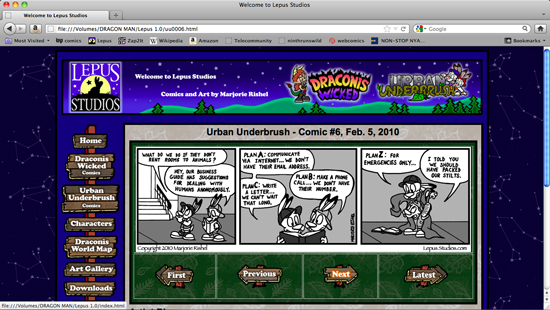
(Eep.)
Sure, some of the pieces aren't bad on their own and you can sort of see how this mess evolved into the current version. But the amount of clutter... How did I not notice all the clutter? And if I was blind to the clutter back then, how do I know I'm not blind to terrible amounts of clutter right now? So, with paranoia as my guide, gave the site a little overhaul. It's now leaner and cleaner than ever before.
I may be making some minor tweaks as the new site settles in, but, for the most part, you can just enjoy the new site...at least until next year...Maybe.
-Marj
Wednesday, March 14, 2012
Urban Underbrush Readers' Poll Results
1. Who’s your favorite character?
First Place: Maxwell (40%)
Second Place: Dynamite & Detonator / Vincent / Scatter (15% each)
Third Place: Leslie (10%)
Fourth Place: Cassidy (5%)
I’m not surprised that Max is the favorite. He’s a nice guy who gets the best pop culture jokes. I’m glad that Dynamite and Detonator made a decent showing since they often carry the stories. Vincent was a surprise. He’s so quiet I was wondering if you even noticed him. The rest of the cast did about as well as I expected.
2. Which settings would you like to see?
First Place: House and Roof Garden (45%)
Second Place: City (40%)
Third Place: Visit other places (15%)
Actually, these results reflect how often I intended to use these settings anyway. About 50% to 60% of the story will take place in the house, 40% in the rest of the city and 15% in some other locations.
3. Explosions?
First Place: There are enough explosions (60%)
Second Place: We need more explosions (40%)
Everyone likes a good explosion, but you guys clearly understand that they probably can’t happen all the time. Urban Underbrush has continuity. It’s not the kind of cartoon where everything falls apart one week, and then it’s inexplicably fine the next week. Plus, the characters make a big deal over how important their home is. So I can’t be blasting pieces off of it every other week. I do promise to blow things up whenever I can get away with it.
Not surprisingly, no one voted for fewer explosions.
4. Human Stories or Animal Stories?
First Place: Mix (90%)
Second Place: humans only/animals only (5% each)
I’ve always liked stories with both animal and human characters interacting. I really don’t see the point in keeping them apart.
5. Romance Stories
First Place: Keep doing what you’re doing. (45%)
Second Place: More stories where Vincent and Leslie do couple things. (25%)
Third Place: Vincent and Leslie are creepy. Make someone else hook up with someone. (20%)
Fourth Place: Keep it to a minimum. (10%)
I kind of screwed up this question. That line about Vincent and Leslie being creepy was based on something a friend of mine had said about my comics many years ago. I thought it would be funny to include it in the survey. But many of you like seeing Vincent and Leslie together but ALSO want to see other characters hook up, so I couldn’t get an honest answer from that line of questioning.
Most of you seem interested in some light romance stories. Not a lot of people flat-out objected to them anyway.
6. Favorite Chapter?
First Place: Ch 5 - Bicycle Ride (42%)
Second Place: Ch 2 - Storage Problems/Ch 4 - Grass Roots History (16% each)
Third Place: Ch 1 - Rabbits Move In (11%)
Fourth Place: Ch 6/ Ch7/ “I haven’t read all the chapters” (5% each)
Fifth Place: Ch 3 - House Warming Party (0%)
I hope to do more wacky stories like Chapter 5. It’s easier to write this kind of story now that we’ve settled in and met everyone.
I’m not surprised that Chapter 3 received the fewest votes. It’s the shortest, most uneventful chapter. Its only real function is to transition into Chapter 4. Some of the individual comic strips are pretty funny, but, as a whole, it can’t compete with the longer stories.
7. How often do you read Urban Underbrush?
First Place: “I check every update” (75%)
Second Place: “I check every few weeks” (25%)
My sponsors should be glad to hear this.
8. Least Favorite Character
First Place: “ I can’t answer this” (40%)
Second Place: Caius / Blair (20% each)
Third Place: Clive (10%)
Fourth Place: Cassidy / Scatter (5% each)
I’m genuinely surprised to learn that people don’t like jerks. That’s not sarcasm. I honestly thought people loved selfish, cynical, mean characters in cartoons.
I’m not planning on making any changes based on these results. The least favorite characters only “won” by a small margin. Not enough of a negative reaction to cut them or change them. Besides, we’d have a pretty boring story with no antagonists.
Oddly, Clayton and Slasher are the only characters who received no votes for “Favorite” or “Least Favorite.” Cassidy and Scatter are the only characters who received votes for both “Favorite” and “Least Favorite.”
So there you have it. That’s what people think of Urban Underbrush (as much as we can trust an internet survey.) My thanks to everyone who took the time to share their opinions. Maybe next time, I’ll give you a free wallpaper or something.
-Marj
Sunday, March 4, 2012
Moving Day
My first mistake was doing too much research. The web resources I found always included some worst-case-scenario stories about web hosts who punished customers for leaving. Apparently, in the 90's, hosts would often register a site in their own name (instead of in the customer's name) so if the customer tried to leave he was told that he could not continue using the same domain name and address unless he stayed with his current provider. These days, a grudging host will just bury the transfer directions and/or stall on sending the necessary transfer codes. It turns out that my old host was very accommodating when I asked for transfer codes and instructions. Unfortunately, my research had put me so on edge that when I finally contacted tech support my help requests sounded like I was making demands in a hostage situation. Sorry, tech support.
Time was my other enemy. I had planned on making the move two weeks before my old contract expired. This way, I wouldn't be paying for two hosts at once for very long, but if something went wrong, I'd still have some time to make adjustments. It was almost a perfect plan, but a personal crisis or two made me push the move back for a week. It turns out that, while you can change servers in a few hours, it is currently impossible to transfer a domain name in less than a week, so if your domain expires in less than a week, you need to renew for the year before you are even allowed to begin the transfer process. Sigh.
All's well that ends well. I'm set up on the new server, which has shown little or no signs of disappointing me. You readers probably won't notice the change, but you might find the site a little faster, more reliable and easier to find on search engines. Keep me posted.
-Marj
Sunday, January 8, 2012
A Quest for Freedom
As a cartoonist, I’m the kind of person who spends a lot of time stepping in and out of fantasy worlds. So it’s important that I try to keep up with world events as much as I can. It keeps me from becoming too disconnected. Still, I was amazed when I discovered Comic Creators for Freedom last winter (back when they were still “Comic Creators Alliance”). Comic Creators for Freedom [www.comiccreatorsforfreedom.com] unites cartoonists to help raise awareness and support for the fight against human trafficking – the buying and selling of human beings. I wasn’t surprised to learn that such a charity existed. I was surprised to learn how necessary it was. Up until then, I had thought of slavery as something from the past, something that may still exist on a smattering of small countries in distant parts of the world. Wrong. There is an estimated 27 million people being kept as slaves in the world today.* Even in industrialized countries, like here in American, humans are bought and sold. Even children and young girls are being kidnapped off the streets or from school bus stops. They are ripped from their families and abused in every way imaginable.
January 11 is National Human Trafficking Awareness Day (in the United States) and Comic Creators for Freedom is starting their annual donations drive. This year, 127 different cartoonists have contributed a drawing of one of their female characters. These drawings have been assembled into one super drawing. Many popular webcomics have joined in this year, including Girls with Slingshots, The Dreamland Chronicles, Kukuburi, Earthsong Saga, Looking for Group, Love and Capes, The Dreamer, and even Draconis Wicked (look for Flight. I haven’t seen it yet, but I think she’s on the right.)
Anyone who donates to CCF can download the image to use as desktop wallpaper. All profits will be split evenly between Gracehaven [www.gracehavenhouse.org] and Love 146 Round Home [love146.org], two groups that help rehabilitate the rescued victims of slavery.
The donations drive will run from January 9th to January 20th so if you want a wallpaper, don’t wait too long.
Please note that the drawing itself does not include any illusions to slavery or other dark themes. It is safe for work and children.
I am honored to be able to take part in this. My deepest thanks to anyone who donates, or even passes the word along.
-Marjorie Rishel
(*facts and statistics courtesy of Comic Creators for Freedom [www.comiccreatorsforfreedom.com])
